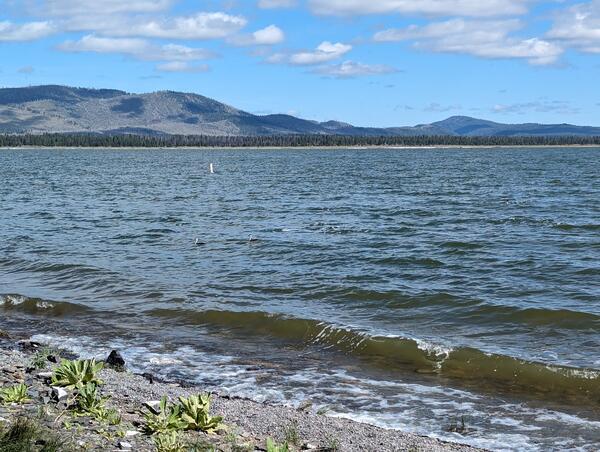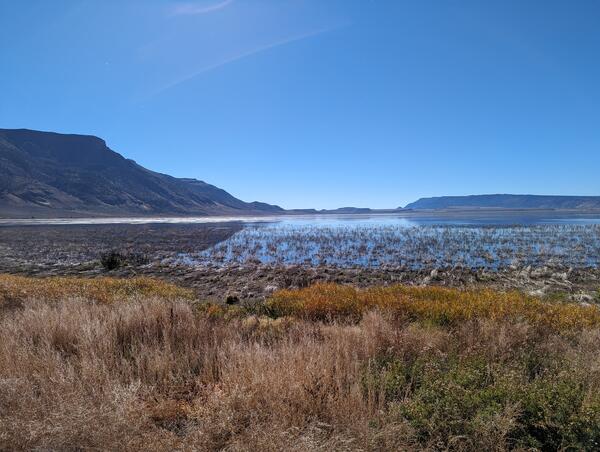Lake Abert, Oregon is one of the 20 terminal lakes identified by USGS partners as priority ecosystems for study by the Saline Lakes Ecosystems IWAA.
Multimedia
If you are unable to access or download a product, email SalineLakeEcosystemsIWAA@usgs.gov.
Images
Lake Abert, Oregon is one of the 20 terminal lakes identified by USGS partners as priority ecosystems for study by the Saline Lakes Ecosystems IWAA.
Eagle Lake, located in northeastern California approximately 16 miles north of Susanville in Lassen County, sits at an elevation of 5,100 feet above sea level. It is the second largest natural freshwater lake entirely within California. Eagle Lake is within the Great Basin, with all incoming waters remaining in the lake without outflow.
Eagle Lake, located in northeastern California approximately 16 miles north of Susanville in Lassen County, sits at an elevation of 5,100 feet above sea level. It is the second largest natural freshwater lake entirely within California. Eagle Lake is within the Great Basin, with all incoming waters remaining in the lake without outflow.
Goose Lake, on the Oregon-California border, is one of the 20 terminal lakes identified by USGS partners as priority ecosystems for study by the Saline Lakes Ecosystems IWAA.
Goose Lake, on the Oregon-California border, is one of the 20 terminal lakes identified by USGS partners as priority ecosystems for study by the Saline Lakes Ecosystems IWAA.

Summer Lake, Oregon is one of the 20 terminal lakes identified by USGS partners as priority ecosystems for study by the Saline Lakes Ecosystems IWAA.
Summer Lake, Oregon is one of the 20 terminal lakes identified by USGS partners as priority ecosystems for study by the Saline Lakes Ecosystems IWAA.
Around Hart Lake, hundreds of bird species either reside or stop during migration. Nesting species include sandhill cranes, American white pelicans, double-crested cormorants, willets, Wilson's phalaropes, gadwalls, northern shovelers, American coots, western grebes, Clark's grebes, black-crowned night herons, Canada geese, mallards, and various ducks and terns.
Around Hart Lake, hundreds of bird species either reside or stop during migration. Nesting species include sandhill cranes, American white pelicans, double-crested cormorants, willets, Wilson's phalaropes, gadwalls, northern shovelers, American coots, western grebes, Clark's grebes, black-crowned night herons, Canada geese, mallards, and various ducks and terns.
A female Wilson’s phalarope with 2-gram Sunbird PTT transmitter. Wilson's phalaropes spin around in the water to stir up invertebrates to snack on. Large flocks gather on terminal lakes in the American west before migrating as far as southern most South America.
A female Wilson’s phalarope with 2-gram Sunbird PTT transmitter. Wilson's phalaropes spin around in the water to stir up invertebrates to snack on. Large flocks gather on terminal lakes in the American west before migrating as far as southern most South America.
Videos
 American Avocets at Malheur National Wildlife Refuge
American Avocets at Malheur National Wildlife Refuge
American Avocets with long grey legs, white body feathers, and white and brown wing feathers, dip their long, narrow grey beaks in and out of shallow water as they search for food. Their bodies reflect off of the pond surface as they move along at Malheur National Wildlife Refuge in southeast Oregon.
American Avocets with long grey legs, white body feathers, and white and brown wing feathers, dip their long, narrow grey beaks in and out of shallow water as they search for food. Their bodies reflect off of the pond surface as they move along at Malheur National Wildlife Refuge in southeast Oregon.






